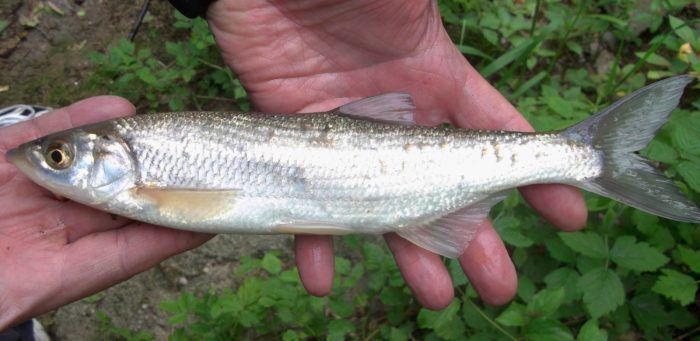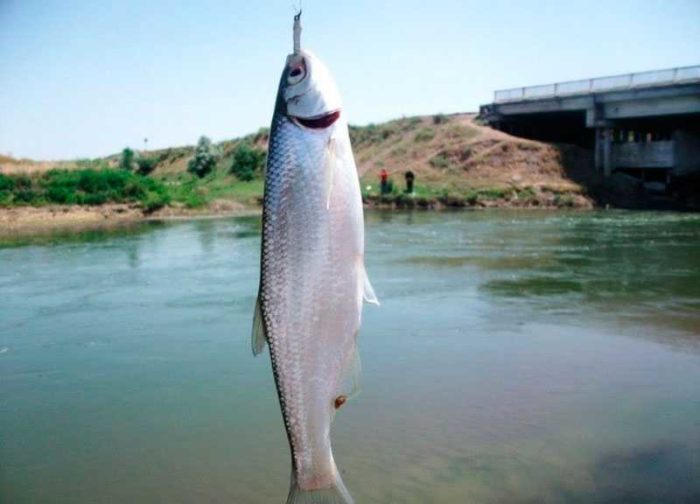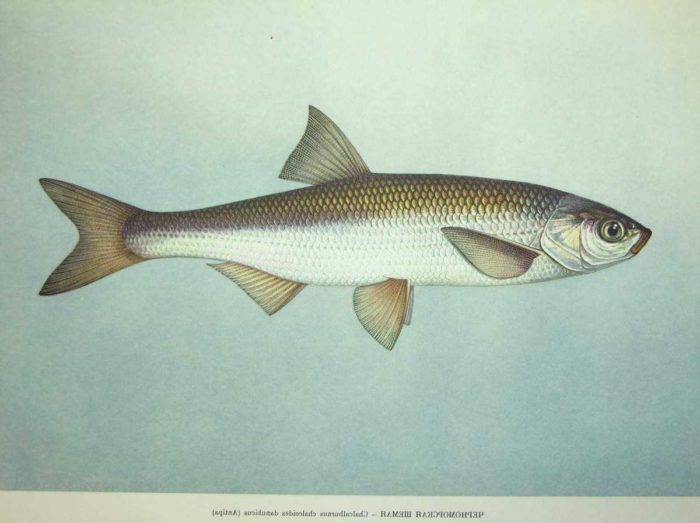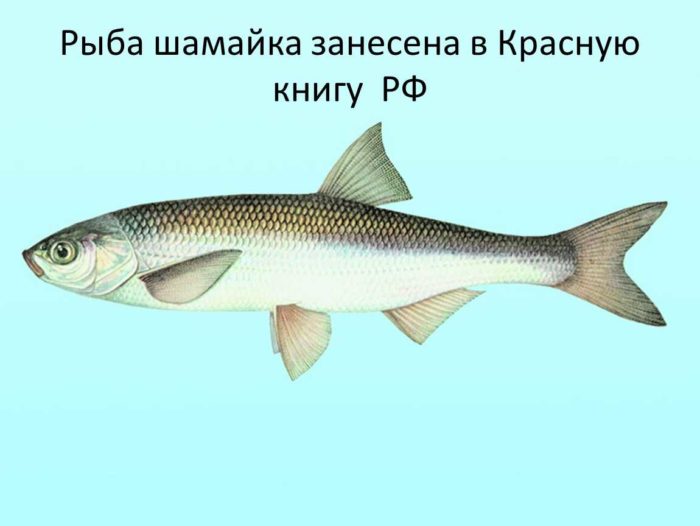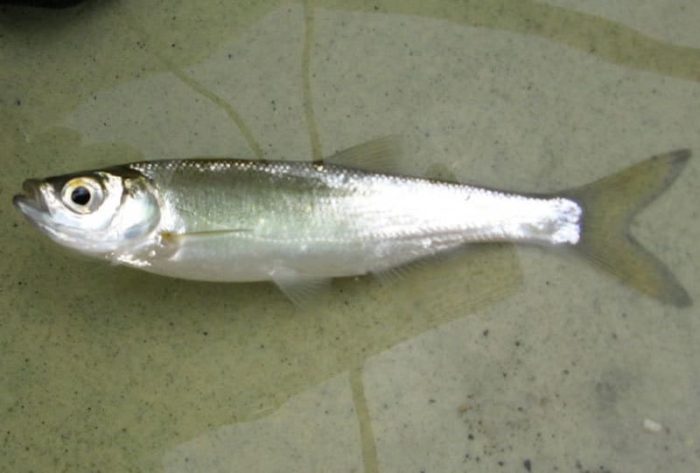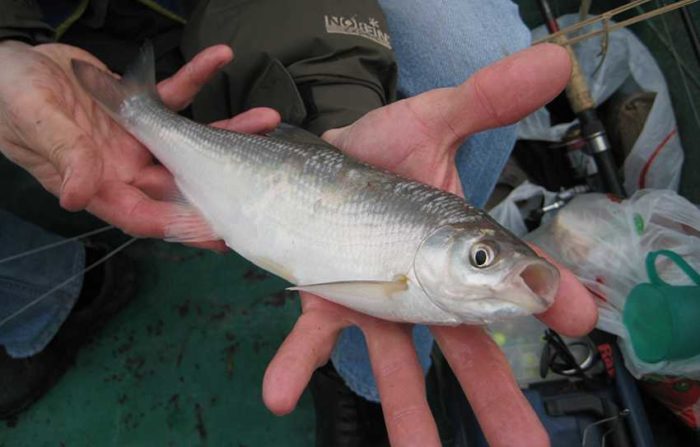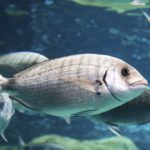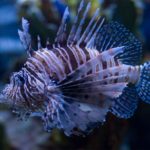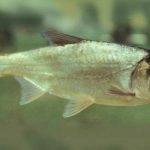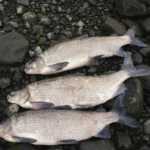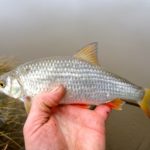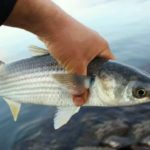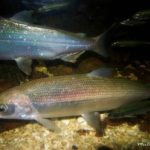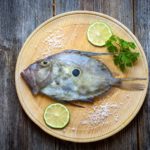Shamayka is a fish that is widely distributed in the Black and Azov Seas. It has excellent taste and contains many valuable components. That’s why both professional fishermen and amateurs fish for this fish. Intensified fishing has led to its almost complete disappearance. In 2006, it was included in the Red Book. However, poachers continue to catch them even now.
Description of the fish
This fish has been known since ancient times. It was first mentioned in the Persian state.The name of the individual is translated from Farsi as “royal fish”.
Appearance
In terms of visual characteristics, the king fish is more reminiscent of an ordinary bleak. Its characteristic features include:
- silvery scales – on the sides it has the brightest color;
- greenish skin color;
- body flattened laterally;
- bluish tints on the head;
- large lower jaw;
- reddish-orange color of the front fins.
A characteristic feature of the shamaika is the strongly retracted dorsal fin. The fish straightens it when it needs to move quickly or when danger appears.
Habitat
The main condition for the normal existence of this fish is considered to be clean water, which contains a lot of oxygen. Shamayka lives in the following places:
- the basins of the Caspian, Azov and Black Seas and the rivers that flow into them;
- Aral Sea;
- the Kuban and Don rivers;
- mouths of the Kura and Terek.
Black Sea species are able to move to the Dnieper and Dniester. Small populations of these fish are found in western Europe. They live in the Danube basin. These individuals are also found in the Bavarian Reservoir.
Nutrition
The shamaika appears to be an omnivorous fish. But as individuals grow, they begin to eat more and more animal food. Little by little, small beetles and worms begin to dominate the diet. The shamaika also eats small fish of other species. In addition, it readily absorbs mosquito larvae. At the same time, fishermen who catch shamaika note that it bites well on bread and various types of porridge.
Natural enemies
The main natural enemies of the fish, which is often mistakenly called the shaman, are considered to be large predators. These primarily include catfish and pike.At the same time, in sea water the fish feels much more comfortable and safer, since the number of predators relative to the area becomes smaller. At the same time, marine predatory fish also threaten the shamaika population. This, in particular, concerns sterlet, the population of which in the Sea of Azov is very large.
Spawning
Spawning is particularly influenced by the habitat of the fish. Climatic features are also important. For example, in the Kuban River, shamaika breeds from September to April. However, on the Don this happens only in the spring.
Individuals are able to reproduce starting from the third year of life. Before this period, the fish lives in the sea - for example, in the Azov-Black Sea basin. After reaching sexual maturity, a flock of shamaikas moves to the spawning ground. At the same time, it takes them a lot of time to find a suitable place.
Most often, shamaikas prefer places with a rocky bottom, active currents and cool water. Females lay eggs at night. At the same time, it is distributed along the bottom by the current and sticks to the stones. After completing the spawning process, the females return to the sea. In this case, the fry appear only after 5 days. They move into the marine environment only after 1 year. At this point, the weight of the fish does not exceed 1 gram.
Why is this a delicacy?
Both in Rus' and in the Middle East, shamaika has always been considered a delicacy. It is characterized by a delicate taste and high fat content. Therefore, the fish began to enjoy success among crowned heads. The name itself comes from Persia. At the same time, the Russian monarchs gladly accepted him. It is not known who exactly began to call the fish king. However, back in the 19th century, this particular phrase was used to designate the Black Sea shamaika.
Reasons for the high price
Today the fish is listed in the Red Book.However, it was not always on the verge of extinction. Shamaya was once very common. However, its habitat was the southern reservoirs of Russia. Until the mid-19th century, getting there was difficult and expensive. However, it was not possible to breed these individuals in artificial reservoirs. The fish simply did not take root. That's why it was always quite expensive.
Varieties
Biologists distinguish 2 main types of individuals and approximately 30 subspecies. The main varieties of shamaika include:
- Caspian - distinguished by its rather large size. It has gray fins and a dark color. This fish is characterized by excellent taste.
- Azov-Black Sea - considered more rare. In addition, this fish is much tastier than the Caspian fish, which makes it even more in demand. It has bright fins and a shorter body.
Similar fish
In appearance, the king fish resembles many representatives of the Karpov family. At the same time, it is most similar to fish fish. However, he has a taller and narrower body. In addition, the fisherman is less long. It is not as brightly colored as the shamaika. By these characteristics, fish can be easily distinguished from each other if you carefully examine them.
Another similar fish is the Volga herring. However, it is characterized by more noticeable differences. These individuals belong to different families. As a result, they have more noticeable anatomical differences, including skeletal structure. Herring is characterized by a more pronounced forehead. In addition, it has noticeable dark fins.
Is fishing allowed
People are considered the main natural enemies of shamaika. For some time now, catching this fish has become an expensive and dangerous activity. The cost of these individuals exceeds the price of sturgeon - primarily in the Azov Sea.
About a hundred years ago, small fish were caught with a seine. The unique meat was a fishery for the local population, fish farms, and fishing tourists. Gradually the fish population began to decline. The reason for this was the construction of power plants, as well as uncontrolled fishing.
Gradually, work began to restore the population. In special nurseries, people began to breed fry and release them into natural reservoirs. The shamaika was artificially introduced into the water bodies of Kalmykia and Stavropol. The same was done in the Rostov and Volgograd regions. Since 2014, fry have been continuously released. Over the course of a year, this figure reaches 3.5 million.
Gradually the fish population began to grow. Recently, the question of excluding shamaika from the Red Book has even begun to be raised. But the workers of the Azov Research Institute of Fisheries decided not to rush. They moved this fish from endangered to recovering species.
Gradually the position of the shamaika began to improve. However, it is impossible to catch her now. There are high fines for illegal hunting of such species. For 1 fish you will have to pay 2-5 thousand rubles. With mass fishing using nets, you can get a real life sentence. If females are found in the catch, the fine will double.
Despite the adopted regulations, poachers continue to engage in illegal activities.Therefore, people who buy rare fish second-hand automatically turn into accomplices in crime.
It is worth considering that some subspecies are allowed to be caught today. They were removed from the Red Book as the population recovered. It is important to know who to catch, because otherwise you will have to pay a fine for poaching. Its size depends on the status of the criminal:
- for individuals, the fine is 5,000 rubles;
- for officials the amount increases to 15,000 rubles;
- There is criminal liability for mining for industrial purposes;
- Catching during spawning may result in criminal liability.
Use in cooking
Donskaya and any other types of shamaika have excellent taste. That's why they are often used in cooking.
What does fish taste like?
This fish is considered relatively fatty and has a delicate crumbly texture. When prepared correctly, the meat literally melts in your mouth. Fans of this product note that it acquires special taste during fish spawning. However, it is impossible to catch her during this period - criminal liability is provided for this.
The only disadvantage of the fish is the abundance of small bones. They must be removed manually before use. However, very small fish can be eaten directly with the bones - this will not cause any harm.
Useful and harmful properties
100 grams of fish pulp contains only 88 kilocalories. Therefore, it can safely be called a dietary product. At the same time, it contains a large number of proteins, which include essential amino acids. It is also useful for athletes to eat shamaika. It helps them build muscle tissue.Eating this fish allows you to burn a large number of calories and maintain metabolic processes at a normal level. This helps eliminate excess weight.
Shamayka is very useful during pregnancy and lactation. In addition, it should be used by people who constantly face stress or increased physical activity. It is better to give children fish in the form of cutlets, since it contains many small bones.
It is worth considering that shamaika contains a large amount of phosphorus. This element strengthens bone tissue and teeth. This substance also has a beneficial effect on brain function. Fluoride is considered another valuable component of shamaika. It perfectly strengthens bones and helps prevent tooth decay.
The fish also contains zinc, which is involved in the synthesis of hormones. The lack of this substance in the body has a bad effect on the condition of the skin, nails and hair. In representatives of the stronger sex, zinc deficiency provokes problems with testosterone synthesis. As a result, this negatively affects potency. In addition, zinc strengthens the immune system and increases people’s resistance to stress.
Shamayka is considered an absolutely harmless fish. But people with intolerance to fish protein and seafood should eat it carefully. Also, you should not consume a product that has not undergone full heat treatment. This is due to the risk of parasites in the body of this fish.
To improve your health, shamaika should be eaten baked or stewed. At the same time, it is recommended to avoid dried and smoked fish in case of hypertension, liver and kidney diseases. The fact is that such products contain a lot of salt, which worsens the prognosis for these pathologies.
Recipes
Shamayka is characterized by excellent taste. She is considered an elite representative of the Karpov family. Smoked and dried fish are especially appreciated. At the same time, the best taste is typical for fish that was caught during spawning.
An important disadvantage of king fish is the large number of small bones in the meat. To eliminate them, it is worth marinating the fish in a weak vinegar solution. This needs to be done for 6-8 hours.
Finding fresh or frozen fish for sale can be difficult. In most cases it is sold smoked or dried. If you manage to purchase a fresh product, it is recommended to bake it. This can be done in a sleeve or foil. Thanks to this, you will be able to get a very juicy dish.
To prepare fried shamaika, in addition to fish, you will need to take lemon juice, flour, salt, and vegetable oil. You can also add soy sauce if desired. First, the fish must be thoroughly cleaned, the entrails and gills removed. If this is not done, bitterness will be present in the finished dish.
Squeeze lemon onto cleaned fish. If desired, it can be greased with soy sauce and put in the refrigerator for 1.5-2 hours. It is important to note that you should not salt the meat at this stage. While the shamaika is marinating, you need to mix the flour and salt. Before starting cooking, you need to pour oil into the frying pan and heat it. Then the fish needs to be rolled in a mixture of flour and salt, put in a frying pan and fried on both sides until golden brown.
The most common method of preparing shamaika in Rus' was drying. First, it is recommended to place the carcasses in the refrigerator, then sprinkle them with layers of salt. This must be done in a metal container. Then the product must be put back into the refrigerator for 3-4 days.
After the specified time, it is recommended to wash the fish and hang it in a well-ventilated place. After a week, the dish will be ready. Dried shamaika will be an excellent snack for beer.
Cold smoked shamaika is also very popular. The preparatory stage coincides with the preparation of dried fish. However, instead of a week in a draft, the shamaika should be kept under a fan for 12 hours. Moreover, it must be placed head up. Otherwise, all the fat will leave the fish, which will negatively affect the taste of the fish.
After salting, it is recommended to place the carcasses in a smokehouse under cold smoke. Its temperature should not exceed +30 degrees. When choosing wood chips, you can give preference to alder or beech. Chips from any fruit trees will also work. In summer, smoking lasts 4 hours, and in winter – 7.
It’s not for nothing that Shamika is called the king’s fish. It has tasty and healthy meat. However, fishing is prohibited as its population is rapidly declining.

